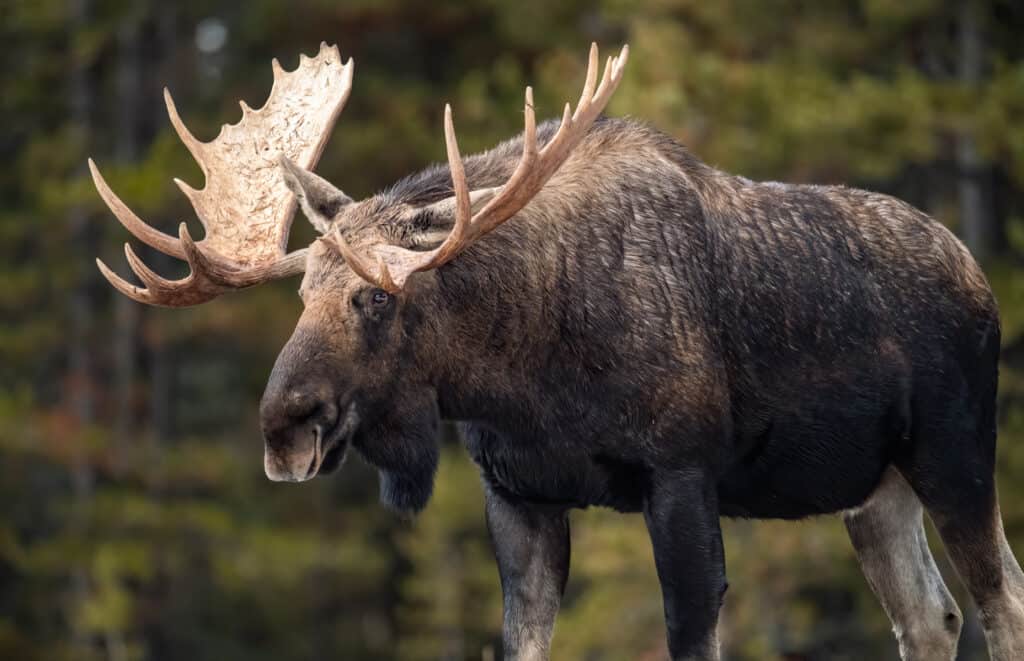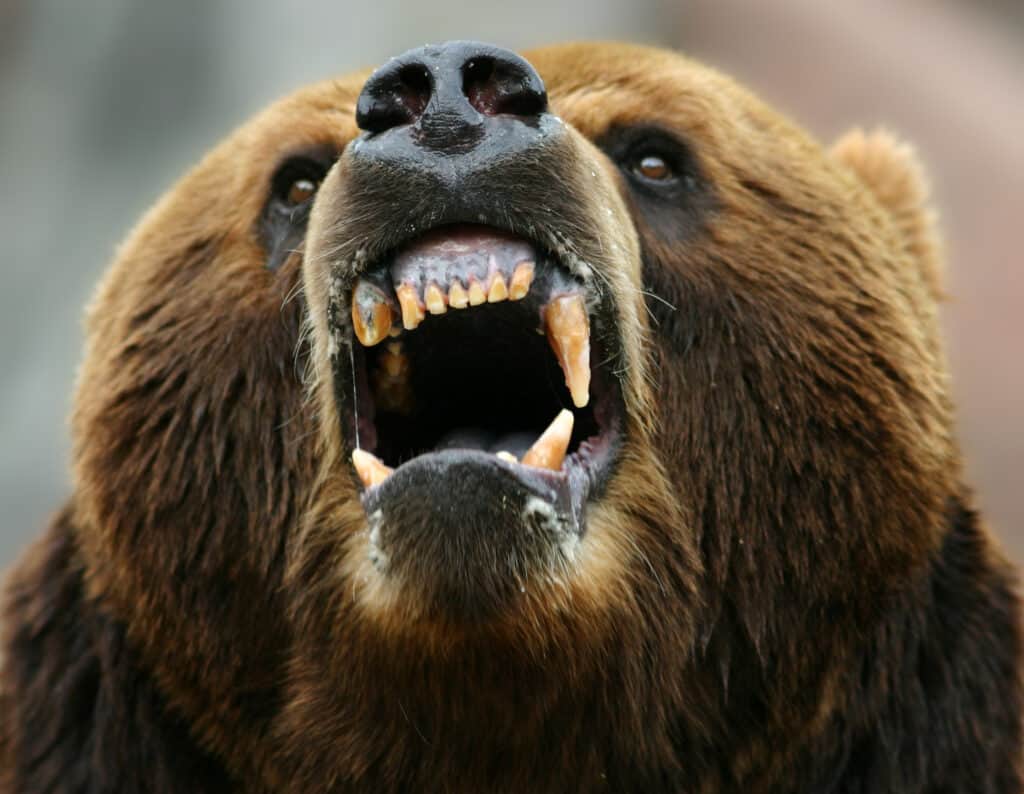Get ready to meet an ancient moose with antlers spanning 8 feet wide. The antlers were fanned out in a palmate design and likely served to attract females rather than fight. This prehistoric creature roamed our planet during the Pleistocene epoch. It’s still unclear if this ancient creature went extinct or evolved into the modern moose we know today. Are you ready to expand your sense of wonder? Follow along as we reveal the life of the ancient broad-fronted moose.
Ancient Moose: Broad-Fronted Moose

The ancient moose is often compared to the Irish Elk; they have a similar appearance.
©Dima Moroz/Shutterstock.com
Cervalces latifrons, also known as the broad-fronted moose or giant moose, was a large deer species belonging to the order Artiodactyla and the family Cervidae. Believed to be ancestors of the modern moose, latifrons could grow just over 7 feet long, with a 7-foot shoulder height, and could weigh between 2,200 and 2,600 pounds. Think American bison size, but taller. Fossilized antlers from the broad-fronted moose, found in Germany, measure 8 feet 2 inches. That’s over 2 feet wider than a modern moose’s headgear.
Where Did This Enormous Moose Live?

The ancient moose was an herbivore who enjoyed roaming the forests and swamps in search of food.
©Nature’s Charm/Shutterstock.com
Cervalces latifrons, the broad-fronted moose, roamed regions spanning Europe and Asia, favoring habitats ranging from tundra to coniferous forests and swamps. The giant moose was an herbivore. Its diet primarily consisted of rough foliage. Sometimes the moose would munch on bark and leaves. They would have had a chance to dine on trees like willow, oak, aspen, and pine. This ancient creature may have also grazed on herbaceous vegetation found in valleys.
During the time Cervalces lived in the Fornaci di Ranica area, the surroundings had different types of vegetation. It was paradise for these large moose. There were scattered conifer forests with trees like Pinus sylvestris, along with dry meadows and moist meadows. The moist meadows were plentiful with certain kinds of plants called forbs. And there were also areas with shallow water with plenty of halophytes, plants that naturally grow in saline environments.
Instead of dense deciduous forests, where antlers get caught in tree limbs, this ancient moose prefers swampier living conditions. Research comparing the broad-fronted moose’s physical features with the modern moose, scientists believe it is well-suited for marshy habitat. In these swampy conditions, with bushes and scattered debris, the ancient moose could find plenty of food and shelter without their large antlers bumping into things.
Fossil Sites

Italy is one of the fossil sites for the ancient moose
©iStock.com/okfoto
Fossil findings show ancient moose lived in Italy and all over Europe. Fossils of the ancient moose were found in Haute-Loire, France, and Mauer, Germany. These places have given us valuable information about where the ancient moose lived in those regions showing that the ancient moose was spread across Europe. Siberia is another important place for finding ancient moose fossils. Many discoveries have been made there, giving scientists a lot of information about where these moose used to live and how they fit into the Asian landscape.
Ancient Palmate Moose Antlers

Modern moose still have palmated antlers, but the ancient moose’s antlers were at least 2 feet wider.
©Harry Collins Photography/Shutterstock.com
The broad-fronted moose’s antlers could reach 8 feet across, and they were palmate similar to an Irish elk’s. Not all ancient moose had palmate antlers, but the broad-fronted moose did. The ancient antlers were much wider than a modern moose’s, and had a number of points.
What did they use their antlers for? The answer depends on who you ask. There are different theories regarding the function of the ancient antlers. Some scientists believed that they served a defensive purpose against predators, while others suggested they were primarily used for sexual displays during courtship, similar to the way modern deer use their antlers. The broad-fronted moose was a solitary animal, living a mostly independent life, so conflicts were rare. It’s likely they used their antlers for display rather than combat.
Ancient Moose’s Large Antler Growth
How did the broad-fronted moose antlers grow so large? Studying the Irish elk’s evolution may provide some insight. In the past, people believed the antlers of the Irish elk kept growing bigger uncontrollably, but now we know there isn’t enough evidence to support this idea (known as orthogenesis). Now, sexual selection is looking like the more likely theory. Males with bigger antlers were more successful in finding partners, thus passing on the large antler gene to their offspring.
What Predators Did the Ancient Moose Have?

Brown bears, gray wolves, and dire wolves preyed on the ancient moose.
©PhotoBarmaley/Shutterstock.com
Despite being the largest and heaviest deer species ever known, the broad-fronted moose had its fair share of predators to watch out for. Among them were the cunning gray wolves, the formidable dire wolves, and the mighty brown bears. But there was one predator that truly ruled the ice-age Alaska: the giant short-faced bear. This massive creature roamed the mammoth steppes, weighing thousands of pounds and standing over 9 feet tall on its hind legs. It outclassed even the black bears, grizzly bears, and polar bears in size, making it a formidable native predator of North America for nearly 1 million years.
When Did the Ancient Moose Go Extinct?
When did broad-fronted moose go extinct? The broad-fronted moose went extinct around 100,000 years ago, towards the end of the Pleistocene epoch. The fate of the broad-fronted moose remains a captivating mystery. While some scientists speculate that it might have evolved into the stag moose or the modern moose, there isn’t enough concrete evidence to support this hypothesis. Another theory suggests that the ancient moose didn’t have the opportunity to evolve and instead faced extinction. The mystery of whether the broad-fronted moose transformed into the modern moose or disappeared entirely remains unresolved. It’s plausible that competition with other herbivorous species and hunting activities by early humans could have played a role in its demise.
Similarities With Irish Elk
The broad-fronted moose draws many comparisons to the Irish elk, a closely related North American species. The Irish elk, scientifically known as Megaloceros giganteus, also lived during the Pleistocene Epoch. Standing up to 7 feet tall at the shoulder, its antlers were truly remarkable, sometimes reaching a 13-foot spread. These majestic antlers likely played a role in ritualized combat between male elk, perhaps used to establish dominance or compete for mates.
Despite its name, the Irish elk was not limited to Ireland but rather found across Europe, northern Asia, and northern Africa. Fossils of this magnificent deer have been discovered in lake sediments and peat bogs in Ireland, which is why it is commonly associated with the country. Alive for much longer than the ancient moose, the Irish elk went extinct approximately 10,000 to 11,000 years ago. The exact cause of its extinction also remains a mystery.
Final Thoughts
As we continue to unravel the secrets of these prehistoric giants, the broad-fronted moose remains a reminder of the amazing things nature’s capable of. The broad-fronted moose, an enormous deer species from the Pleistocene epoch, is a testament to the awe-inspiring forms life can take. With a length of over 7 feet, a towering height of 7 to 8 feet, and a weight of around 2,000 pounds, this prehistoric animal was super-sized. And like other animals with antlers, this ancient moose had an impressive set of headgear. Their palmate antlers could reach an expansive 8 feet across.
One of the enduring mysteries is the broad-fronted moose’s ultimate fate. While some theorize that this majestic creature evolved into modern moose. Or maybe the ancient moose disappeared entirely from the planet, and all we have leftt are the clause it’s fossils leave behind.
The photo featured at the top of this post is © GAS-photo/Shutterstock.com
Thank you for reading! Have some feedback for us? Contact the AZ Animals editorial team.







